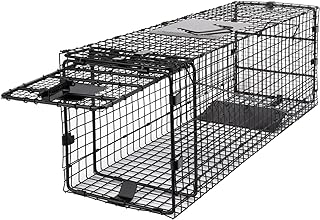Ever wondered why those sneaky felines love to cozy up under mobile homes? It’s more common than you might think. These mischievous creatures often seek shelter beneath these structures, creating a host of challenges for homeowners. From scratched insulation to unpleasant odors, the presence of cats under mobile homes can quickly become a nuisance. So, why do they choose this peculiar hiding spot? Understanding their motives is key to finding effective solutions and in this article Eliminate Cats Under a Mobile Home we will tell you how.
Cats Under a Mobile Home Here’s What to Do
The allure lies in the safety and warmth that mobile homes provide for our furry friends. With ample space and protection from the elements, it’s no wonder cats find solace underneath them. But fear not! There are practical strategies to manage their presence without resorting to drastic measures. By implementing tried-and-true methods, we can ensure harmony between homeowners and their feline neighbors. Let’s explore some effective ways to tackle the issue head-on and bid farewell to unwanted cat lodgers under our beloved mobile homes.

Why Do Cats Choose to Live Under Mobile Homes?
Mobile homes provide a safe and secluded environment for cats. The space beneath these structures offers an ideal hiding spot for felines seeking refuge. Cats are known for their independent nature, and the quiet seclusion under mobile homes provides them with a sense of security.
The space beneath mobile homes also offers protection from various weather conditions. Whether it’s scorching heat or pouring rain, cats can find solace under these structures. The shade provided by the mobile home keeps them cool during hot summer days, while the shelter shields them from getting wet during rainy seasons.
Another reason why cats choose to live under mobile homes is the availability of food sources near mobile home parks. These areas often attract stray cats due to the presence of garbage bins and leftovers discarded by residents. Cats are resourceful creatures and will take advantage of any opportunity to find food easily.
Easiest Way to Remove Cats From Under a Home
Using a live trap to capture a cat is the easiest way to remove cats from under a home. Once you have trapped the animal you can relocate the cat. Having a trap on hand also gives you the opportunity to capture more animals in the future. To order a live trap shipped right to your door step visit this link.
Problems Caused by Cats in Mobile Home Parks
Cat infestations can be a major issue in mobile home parks, leading to a range of problems that can disrupt the living conditions for residents. From foul odors and unsanitary conditions to damage to the infrastructure and health risks, the presence of cats can create numerous challenges.
How to Keep Strays Away
One of the most noticeable problems caused by cat infestations is the foul odor that permeates through mobile home parks. Cats have a tendency to mark their territory, often using urine or feces as a means of communication. This can result in strong and unpleasant smells that linger in the air, making it uncomfortable for residents and visitors alike. These odors can seep into the interiors of mobile homes, further exacerbating the issue.

Beyond the offensive smells, cat infestations also contribute to unsanitary conditions within mobile home parks. The accumulation of cat feces poses serious health risks as it contains harmful bacteria and parasites. Residents who come into contact with contaminated areas are at risk of contracting diseases such as toxoplasmosis or salmonellosis. Moreover, if cat feces find their way into common areas or water sources within the park, it can contaminate these spaces and potentially affect multiple individuals.
Health Concerns: Many Cats Under a Mobile Home
In addition to health concerns, cats may cause significant damage to the infrastructure of mobile homes. Insulation materials are particularly vulnerable to feline activity as cats tend to scratch and tear at them when seeking shelter or marking territory. This damage compromises insulation effectiveness and increases energy costs for residents trying to maintain comfortable temperatures within their homes.
Furthermore, cats’ natural inclination to climb and explore tight spaces puts wiring systems at risk. Their claws can easily puncture electrical wires, creating potential fire hazards while also disrupting power supply throughout the park. Plumbing systems are not immune either; cats may chew on pipes or claw at them out of curiosity or frustration, leading to leaks or even burst pipes.
Get Rid of Cats
Another problem associated with cat infestations in mobile home parks is the increased noise levels. Cats are notorious for their vocalizations during mating calls, which can be disruptive and distressing for residents trying to sleep or relax. Territorial disputes between cats often escalate into fights, resulting in loud screeches and hisses that disturb the peace within the park.
Lastly, allergies are a common concern. Many individuals suffer from allergies triggered by cat dander or fur, making their presence in mobile home parks particularly problematic. Allergic reactions can range from mild symptoms such as sneezing and watery eyes to more severe respiratory issues that require medical attention.
How to Keep Stray Cats Away from Your Mobile Home
Securely seal any openings or gaps around the base of your mobile home.
To prevent stray cats from entering your mobile home, it is crucial to ensure that there are no openings or gaps around its base. Cats can easily squeeze through small spaces, so it’s important to thoroughly inspect and seal any potential entry points. Begin by examining the perimeter of your mobile home, paying close attention to areas where pipes or utility lines enter the structure. Use caulk or weatherstripping to seal any gaps you find. Consider installing wire mesh or lattice panels around the base of your mobile home for added protection against feline intruders.
Remove potential food sources such as uncovered garbage cans or pet food left outside.
Stray cats are often attracted to places that offer readily available food sources. To discourage their presence near your mobile home, it is essential to eliminate these temptations. Start by securely covering all garbage cans and storing them in a location that is not easily accessible to cats. Furthermore, refrain from leaving pet food outside for extended periods of time as this can attract strays. Instead, establish designated feeding times for your pets and promptly remove any uneaten food once they have finished eating.
Peppermint Oil is a Number One Choice to Keep Animals Out
Animals often dislike peppermint oil due to its strong scent and potent properties. Peppermint oil contains menthol, which can be overwhelming to animals’ sensitive noses and may cause discomfort. This intense aroma can be especially bothersome to creatures with heightened olfactory senses, such as dogs and cats.
Click here to order peppermint oil shipped directly to your home today.
Moreover, animals may associate the smell of peppermint with danger or unfamiliarity, leading to avoidance behaviors. In the wild, many plants produce strong scents as a defense mechanism to deter herbivores, and animals may have evolved to instinctively avoid such odors, including those of peppermint oil.
Read more on our article Peppermint Oil Cats: Repellent Solutions

Utilize motion sensor lights or sprinklers as deterrents for stray cats.
Motion sensor lights and sprinklers can be effective tools in deterring stray cats from approaching your property. These devices operate on motion detection technology and activate when triggered by movement in their vicinity. By installing them strategically around your mobile home, you create an environment that is less appealing for feline visitors who prefer dark and undisturbed areas. The sudden activation of bright lights or spraying water will startle the cats and encourage them to seek shelter elsewhere.
Consider using scent repellents like citrus peels or vinegar around your property.
Cats have a strong sense of smell, which can be utilized to keep them away from your mobile home. Certain scents, such as citrus peels or vinegar, are known to repel cats due to their strong odor. Scatter orange or lemon peels around the perimeter of your property or soak rags in vinegar and place them near areas where cats are likely to enter. The pungent smell will act as a deterrent and make your mobile home less attractive to stray cats.
By following these measures, you can significantly reduce the presence of stray cats around your mobile home. Remember to regularly inspect and maintain the seals around your home’s base, remove potential food sources, utilize motion sensor lights or sprinklers, and consider using scent repellents. With these strategies in place, you can create a cat-free environment that ensures peace of mind for both you and your mobile home.
Effective Methods for Removing Cats Living Under Mobile Homes
Contact local animal control services for assistance in trapping and removing cats safely.
When dealing with cats living under your mobile home, it’s essential to seek professional help to ensure the safety and well-being of both the cats and yourself. Local animal control services are equipped with the necessary knowledge and tools to handle these situations effectively. They will help you eliminate cats under your mobile home quickly.

By contacting your local animal control, you can request their assistance in trapping and removing the cats from under your mobile home. These professionals have experience dealing with feral cat populations and will know how to approach the situation without causing harm or distress to the animals.
Animal control officers often use humane traps that are designed specifically for capturing stray cats. These traps are baited with food to entice the cats inside. Once trapped, they can be safely removed from under your mobile home.
Hiring professional pest control services experienced in dealing with feral cat populations can be effective.
If you’re facing a persistent issue with cats living under your mobile home, it may be beneficial to hire professional pest control services. Look for companies that specialize in dealing with feral cat populations as they will have specific strategies and techniques tailored to this situation.
Professional pest control experts understand the behavior of feral cats and can devise effective plans for their removal. They may set up a combination of traps, exclusion methods, and deterrents to address the problem comprehensively.
When hiring professional pest control services, make sure they have experience working with feral cat populations. Ask for references or check online reviews to ensure their credibility and effectiveness in resolving similar issues.
Humane Traps Baited with Food
Humane traps are an excellent tool for capturing stray cats living beneath your mobile home. These traps are specially designed not to harm or injure the animals during capture.
To use a humane trap effectively, place it strategically near areas where you have observed the cats. Bait the trap with enticing food such as wet cat food or tuna, which will attract the cats inside.
Once a cat enters the trap and triggers the mechanism, it will safely close, preventing the cat from escaping. It’s crucial to regularly check the traps to ensure that trapped cats are not left unattended for extended periods. This process is a great way to move these friendly felines to another location quickly and help to eliminate cats under a mobile home.
Relocating Trapped Cats: Eliminating Cats Under a Mobile Home
While capturing stray cats is an essential step in removing them from under your mobile home, relocating them should be handled by professionals who understand local regulations and best practices for humane relocation.
Relocation of feral cats involves finding suitable environments where they can thrive without causing harm to other ecosystems or existing animal populations. Professional organizations are well-versed in these matters and can ensure that any relocated cats have a higher chance of survival and a good quality of life.
Attempting to relocate trapped cats on your own may lead to unintended consequences, such as introducing them into unsuitable habitats or areas where they may face danger or competition for resources. Therefore, it’s crucial to leave this task in the hands of experienced individuals who can make informed decisions regarding relocation.
By following these effective methods for removing cats living under your mobile home, you can address the issue responsibly while ensuring the safety and well-being of both humans and animals involved. Seek professional assistance, utilize humane traps baited with food, and rely on experts for proper relocation when necessary.
Preventing Cat Attraction: Eliminating Temptations and Creating Barriers
Cats under mobile homes can be a nuisance, causing damage and leaving behind unpleasant odors. To prevent these feline intrusions, it’s essential to eliminate temptations and create barriers that discourage cats from seeking shelter beneath your home. Here are some effective strategies to keep those curious cats at bay.
Store Garbage Cans in Secure Containers
One of the main attractions for cats under mobile homes is easy access to food sources. To prevent this, make sure your garbage cans are stored in secure containers that cannot be easily opened by feline paws. Consider investing in sturdy bins with tight-fitting lids or even using bungee cords to secure the lids in place. By removing the allure of readily available food, you reduce the likelihood of attracting unwanted feline visitors.
Avoid Leaving Pet Food Outside
Leaving pet food outside, especially overnight, can unwittingly invite cats to explore beneath your mobile home. The scent of food lingers in the air, acting as a beacon for hungry felines. To deter them, ensure all pet food is brought indoors after feeding time. If you must leave food out temporarily, do so during monitored periods only.
Install Fencing or Barriers
Creating physical barriers around the base of your mobile home is an effective way to discourage cats from entering the area altogether. Installing fencing or barriers prevents easy access and forces them to seek shelter elsewhere. Consider using chicken wire or wire mesh attached securely to existing structures like skirting or lattice work. This will create an obstacle that discourages cats from squeezing through gaps.
Remove Potential Hiding Spots
Cats are naturally drawn to areas where they can hide and feel safe. By removing potential hiding spots near your home, you reduce their incentive to seek refuge underneath it. Trim back overgrown bushes and dense vegetation surrounding your mobile home perimeter. Creating open spaces and removing dense foliage leaves cats with fewer places to hide, making your property less appealing to them.
Preventing cat attraction under your mobile home involves a combination of eliminating temptations and creating effective barriers. By following these steps, you can significantly reduce the likelihood of cats finding their way beneath your home.
Remember, it’s essential to store garbage cans securely to prevent access to food sources. Avoid leaving pet food outside, especially overnight when feline visitors are most active. Installing fencing or barriers around the base of your mobile home is another effective deterrent. Consider using chicken wire or wire mesh as a physical obstacle that cats cannot easily overcome.
Remove Hiding Spots for Cats
Removing potential hiding spots near your home reduces the appeal for cats seeking shelter. Trim back overgrown vegetation and create open spaces that discourage feline intruders.
By implementing these preventative measures, you can enjoy a cat-free zone under your mobile home while ensuring the comfort and safety of both your property and our feline friends.
Ensuring Safety and Humane Approaches in Dealing with Cats Under Mobile Homes
Cats under mobile homes can pose challenges for both homeowners and feline companions. It is crucial to prioritize the safety and well-being of both humans and cats when addressing this issue. By following humane approaches, consulting local animal welfare organizations, and familiarizing yourself with relevant laws, you can effectively manage the situation.
When stray cats find shelter under mobile homes, it is essential to approach their removal or relocation with care. The first step is to contact your local animal rescue or humane society for guidance on humane cat management practices. These organizations have experience in dealing with similar situations and can provide valuable advice on how to address the issue while ensuring the cats’ welfare.
Educating yourself about local laws and regulations regarding trapping, removal, or relocation of cats is vital. Different jurisdictions may have specific requirements that need to be followed to ensure ethical treatment of animals. By understanding these regulations, you can navigate through the process while staying within legal boundaries.
TNR Resources for Cat Problems
Consider implementing trap-neuter-return (TNR) programs as a responsible way to control feral cat populations under mobile homes. TNR involves trapping feral cats, sterilizing them, providing necessary medical care, and then returning them to their original location. This approach helps stabilize cat populations without resorting to euthanasia or relocating them far from their familiar territories.
To effectively implement TNR programs:
Contact local animal welfare organizations or veterinary clinics that offer TNR services.
Set up humane traps designed specifically for capturing cats safely.
Once trapped, take the cats to a veterinarian for spaying/neutering and any required medical treatments.
After recovery, return the sterilized cats back under the mobile home where they were found.
Provide regular food and water sources nearby as part of ongoing support for these colonies.
By following these steps, you contribute towards reducing the number of stray cats under mobile homes while ensuring their well-being.
It’s important to remember that cats seek shelter under mobile homes for various reasons, such as warmth, protection, or access to food sources. Instead of viewing them solely as a nuisance, consider alternative solutions that benefit both humans and animals. For instance, you could provide designated cat houses or shelters near the mobile home to redirect their attention away from potentially hazardous areas.
Educating people in your community about responsible pet ownership can help prevent more cats from becoming strays. Encourage others to spay/neuter their pets and provide proper care and attention. By doing so, we can collectively work towards reducing the number of homeless animals seeking refuge under mobile homes.
Conclusion: Eliminate Cats Under a Mobile Home
In conclusion, managing the issue of cats under your mobile home requires a proactive approach to ensure the safety and well-being of both the cats and residents. Understanding why cats choose to live under mobile homes helps in implementing effective strategies to address this problem.
The presence of cats in mobile home parks can lead to various problems, including damage to property, noise disturbances, and potential health risks. It is crucial to take steps to keep stray cats away from your mobile home by eliminating temptations and creating barriers.
Removing cats living under mobile homes can be challenging but necessary. Employing humane methods such as trap-neuter-return programs or seeking assistance from local animal control agencies can help resolve this issue effectively.
Final Thoughts: Eliminate Cats Under a Mobile Home
Preventing cat attraction is key in maintaining a cat-free environment around your mobile home. This involves eliminating food sources, securing garbage cans, and sealing off potential hiding spots that may attract stray cats.
In dealing with cats under mobile homes, it is essential to prioritize safety and adopt humane approaches. Avoid using harmful deterrents or methods that may cause harm to the animals. Instead, focus on implementing preventative measures while ensuring the well-being of both humans and feline inhabitants.
To address the issue at hand successfully, it is important for residents of mobile homes to come together as a community. By working collectively and sharing information about effective strategies, you can create an environment that discourages stray cats from taking up residence beneath your homes.

Remember that addressing the issue of cats under your mobile home requires ongoing efforts and cooperation among all residents. By taking action today, you can contribute towards creating a safe and comfortable living environment for everyone involved.
If you have other animals under your mobile home read our article:
Rodents or Pests Under Your Mobile Home
FAQs: Eliminate Cats Under a Mobile Home
Are there any health risks associated with having cats under my mobile home?
Yes, having cats under your mobile home can pose health risks such as fleas infestations or transmission of diseases through their feces or scratches.
How do I prevent stray cats from coming near my mobile home?
To keep stray cats away, you can eliminate food sources, secure garbage cans, and create physical barriers such as fences or mesh to prevent access.
What should I do if I find kittens under my mobile home?
If you find kittens under your mobile home, it is best to contact local animal rescue organizations or shelters for assistance in safely rescuing and rehoming them.
Can I use traps to remove cats living under my mobile home?
Yes, using humane traps can be an effective method for removing cats. However, it is important to follow local regulations and seek guidance from professionals to ensure the safety of both the cats and yourself.
How can I discourage cats from entering my property altogether?
You can deter cats by planting cat-repellent plants like lavender or rosemary, using motion-activated sprinklers, or applying citrus-scented repellents around your mobile home.
You might also be interested in our articles:
Mobile Home Flood Protection: Essential Tips for Safety


